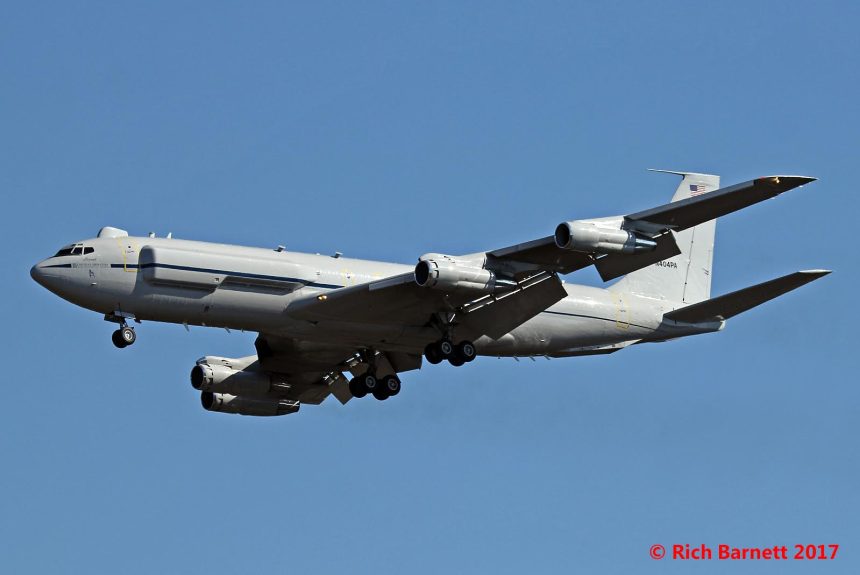Dubbed “Hannah”, a heavily modified Boeing 707 is operated by MIT Lincoln Laboratory for the Air Force as a communications and sensor testbed used in the development of integrated networking and airborne sensing.
Taken on Apr. 14, 2017 at Hanscom Air Force Base, Massachusetts, by photographer Rich Barnett, the images in this post show the pretty rare Boeing 707-321B carrying civil registration N404PA.
The aircraft, currently known as “Hannah” (previously “Paul Revere”), flew with Pan Am for many years since 1965 before being purchased by the Air Force. Currently, it is operated by a joint venture between the Air Force’s 350th Electronic Systems Wing and M.I.T.’s Lincoln Labs.

Under the radio callsign “Research 4 Papa Alpha”, the aircraft is used for testing airborne battle management, command, control and communication technology and concepts. Back in 2004, a rare U.S. Air Force release on the somehow mysterious Boeing 707 provided some detail about its mission ahead of the participation to JFEX 04.
Here’s an excerpt:
“Paul Revere […] is the name given to a task force of Air Force, Department of Defense workers and government contractors flying in a contracted government Boeing 707, allowing warfighters to experiment with and test the latest communication technology.
[…]
Task Force Paul Revere, an airborne battle management command, control and communications application, helps makes testing machine-to-machine capabilities and global communication experiments possible by sending and receiving data between other airborne and space sensors and the Combined Air and Space Operations Center. This capability could allow United States and coalition warfighters from all services to simultaneously communicate from around the globe.
Currently, aircraft such as the Rivet Joint, Joint Surveillance Target Attack Radar System, U-2 or Airborne Warning and Control System take in information that is saved on disks, analyzed and manually sent to warfighters and planners. Today’s output bandwidth from these aircraft is limited. Task Force Paul Revere experiments with the capability of taking in information from ground, space and air assets and simultaneously and instantly sending the information back out on a global network that includes the CAOC. ”
During JEFX, Task Force Paul Revere is connecting information to Washington and routing it back through the base here.
“In fact, it was suggested Task Force Paul Revere look at AWACS and JSTARS top issues and work them,” Colonel Painter said.
The Boeing 707 being used, formerly a commercial airliner, was pulled out of the aircraft bone yard in the 1980s and turned into a flying laboratory in 2001 by workers at the Massachusetts Institute of Technology Lincoln Laboratory. […]
Though the plane is maintained and flown by lab workers, the aircraft and everything on it belongs to the U.S. government.
“It’s part of a contract we have,” said Dr. Joe Chapa, associate group leader at the lab. “Everything bought or developed for this aircraft belongs to the government. Our main mission is to be a learning organization and then transition the lessons learned to the government.”
The Paul Revere is just one application of the aircraft. Many initiatives are being, and have been, tested aboard the 707 with the help of Task Force Paul Revere.
“We like to think of this flying laboratory as a Mr. Potato Head,” Dr. Chapa said. “We can put a different nose or a different eye on.”
Task Force Paul Revere is a team made up of electronic specialists from the Electronic System Center at Hanscom Air Force Base, Mass., aircraft maintainers and operators from MIT’s Lincoln Lab, and operations experts from the Air Force Command and Control ISR Center, Air Combat Command and Air Force Space Command.”
Since then the problem has been partly solved (using solutions like the BACN platform) and the aircraft has been involved in other tests.
For instance, according to the MIT website, in the Summer of 2008, the N404PA carried out secure extremely high frequency (EHF) satellite communications tests whereas in June 2009, the flying laboratory was involved in demonstrating next-generation antenna for airborne communication with Milstar.
What the aircraft is currently testing is unknown. Any idea?
A big thank you to Rich Barnett for allowing us to use his photographs. Don’t forget to visit his Flickr photostream here.









